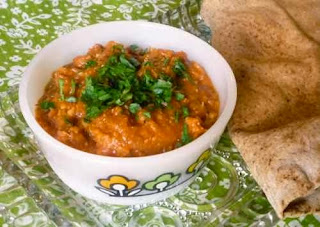adapted from
How to Cook Everything Vegetarian by Mark Bittman Serves 6Filling:
1/2 cup kasha
1 1/2 cups vegetable stock
1/2 tablespoon butter or extra virgin olive oil
2 cups grated parsnips (about 8 ounces)
2 cups grated sweet potatoes (about 8 ounces)
1 shallot, coarsely chopped
6 cloves garlic, minced
1 tablespoon fresh thyme, chopped or 2 teaspoons dried thyme
salt and pepper to taste
1/2 cup provolone, grated (optional)
Phyllo Crust:
8 to 12 sheets phyllo dough, thawed overnight
7 tablespoons butter, melted or 1/2 cup (less 1 tablespoon) extra virgin olive oil
OR
Traditional Pie Crust:
2 whole wheat pie crusts, thawed
InstructionsPreparation:
Wash, peel, and grate sweet potatoes and parsnips. Chop garlic, shallot, and fresh thyme. For phyllo variation, lightly coat pie pan with oil, butter, or cooking spray.
1) Preheat oven to 350 degrees.
2) In a medium saucepan, bring vegetable stock to a boil. Stir in kasha, reduce heat, and simmer for about 20 minutes, until water is absorbed and grains are fluffy. Set aside.
3) Heat oil or butter in a large heavy-bottomed skillet. Add grated vegetables, shallot, garlic, salt, and pepper and cook for 10 to 15 minutes, stirring often. Add a few splashes of water if mixture sticks to bottom of pan.
4) Combine kasha, cooked vegetables, thyme, and optional cheese.
Eleganza Phyllo Dough Variation5) Dampen clean tea towels or paper towels, enough to cover unrolled phyllo dough. Ring out so that they are just damp, not dripping wet. Unroll phyllo dough.
6) Peel up one sheet and place in greased pie plate. Cover unrolled sheets with damp toweling to keep from drying out. Baste phyllo pastry you've placed in pie plate with melted butter using a soft-bristled brush. Repeat four to five times, basting each layer and turning the sheets slightly as you go around.
7) Add filling to phyllo crust. Repeat step six with four to six sheets of phyllo dough to form the top crust. Fold up the edges and basted to seal.
8) Score top and bake for 30 to 40 minutes. Allow to cool before cutting. Serve with a green salad or sauteed greens and sparkling conversation.
Everyday Whole Wheat Crust Variation5. Add filling to defrosted pie crust. Place second crust on top of filling, trim away excess, pinch edges together, and score top.
6. Bake for 30 to 40 minutes. Allow to cool before cutting. Serve with a green salad or sauteed greens and biting political discourse.
Approximate Calories, Fat, Fiber, Protein, and Price per ServingPhyllo/Dairy Variation: 418 calories, 25g fat, 4.6g fiber, 11g protein, $.97
Whole Wheat Crust/Dairy-free Variation: 418 calories, 23g fat, 9.6g fiber, 8.5g protein, $.97
Calculations1/2 cup kasha: 283.5 calories, 2g fat, 8.5g fiber, 9.5g protein, $0.46
1 1/2 cups vegetable stock: 15 calories, 1.5g fat, 0g fiber, 0g protein, $0.16
1/2 tablespoon butter: 70 calories, 7.5g fat, 0g fiber, 0.5g protein, $0.08
2 cups grated parsnips: 100 calories, 0g fat, 6g fiber, 3g protein, $0.36
2 cups grated sweet potatoes: 224 calories, 0g fat, 8g fiber, 4g protein, $0.68
1 shallot: 30 calories, 0g fat, 3g fiber, 2g protein, $0.20
6 cloves garlic: 24 calories, 0g fat, 0g fiber, 0g protein, $0.07
1 tablespoon fresh thyme: negligible calories, fat, fiber, protein, $.02
salt: negligible calories, fat, fiber, protein, $.02
pepper: negligible calories, fat, fiber, protein, $.02
1/2 cup provolone: 392 calories, 28g fat, 0g fiber, 28g protein, $1.48
8 sheets phyllo dough: 392 calories, 4g fat, 2g fiber, 12g protein, $1.84
7 tablespoons butter: 980 calories, 105g fat, 0g fiber, 7g protein, $1.05
OR
2 whole wheat pie crusts: 1760 calories, 128g fat, 32g fiber, 32g protein, $4.39
TOTALS (Phyllo/Cheese Variation): 2510.5 calories, 148g fat, 27.5g fiber, 66g protein, $5.82
TOTALS (Whole Wheat Crust/Dairy-free Variation): 2506.5 calories, 139g fat, 57.5g fiber, 51g protein, $5.84
PER SERVING (TOTALS/6): 418 calories, 25g fat, 4.6g fiber, 11g protein, $.97
PER SERVING (TOTALS/6): 418 calories, 23g fat, 9.6g fiber, 8.5g protein, $.97
 Eating celery before or when making love can perceived by man and woman. Celery (Apium graveolens L) mention as viagra vegetable, or vegetables that efficacy of stimulant drugs like Viagra (sildenafril). The term was popularized by 3 researchers from United, namely Dr Judy Garman, Dr. Walter Gaman and Dr. Mark Anderson.
Eating celery before or when making love can perceived by man and woman. Celery (Apium graveolens L) mention as viagra vegetable, or vegetables that efficacy of stimulant drugs like Viagra (sildenafril). The term was popularized by 3 researchers from United, namely Dr Judy Garman, Dr. Walter Gaman and Dr. Mark Anderson.






